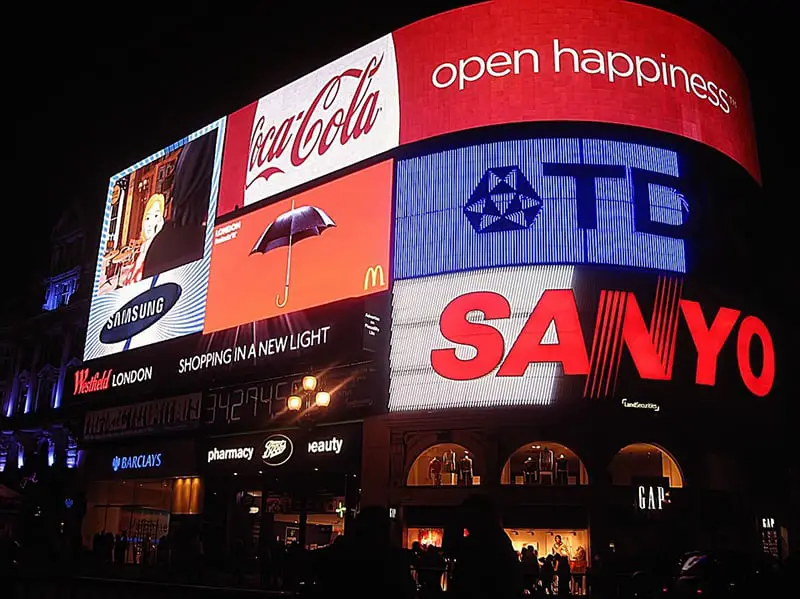Click here to get this post in PDF
Signage is such a ubiquitous part of our world that we scarcely ever consciously notice it, but it plays a vitally important role in the ecosystem of business – and a company without signage might be missing important opportunities for branding, customer acquisition, and more.
Whether they be permanent signs adorning a building or street feature, or temporary installations to advertise a promotion or message, signs are a fundamental feature of the business landscape. Let’s look at some ways that good signage can boost your brand and some different uses for signs in your company.

Why are signs important?
A survey conducted by FedEx in 2012 found that almost eight out of ten (76%) consumers will enter a shop they’ve never visited before on the strength of the signage. Not only that, but 52% of those polled said they would be reluctant to enter a shop that had a poor-quality sign, and 60% reported that they would be put off from an establishment that featured no signage at all. The message is clear: signs make a difference.
Especially for a newly-established business,
signage is crucial for communicating to the world what your company is and what
it offers. An unmarked retail outlet might sell anything from electronics to
shoes or pet food – and how would the public know without being told?
In terms of branding, signage conveys the personality and character of your
business. The heavy metallic serif lettering of a bank or law firm’s signage
would be inappropriate for a doughnut shop, and vice versa. Therefore, we might
say that no signage can also imply no personality.
By not seeming to communicate or stand for anything, your business can come across as a bit of an uninspiring blank slate. Should customers associate you with trustworthy, discreet formality – or relaxed and playful leisure?
Of course, in today’s world signage is everywhere. In order to have any hope of competing for the attention of the public, you’re going to need to get some of your own – or your business may just go unnoticed. Consider investing in outdoor signage for business to make a lasting impression.
What signage says about your business
The design of your signage can speak volumes about the products, services and values of your business. By carefully identifying key things to communicate and finding good ways to express them visually, you can commission signage that always puts your company’s best foot forward.
Typography, colours, imagery, sizing and many other factors can have an effect on the way your business is perceived by visitors. A large, colourful sign might invoke a friendly and sunny customer experience, whilst a darker sign with formal typography could imply a respectable and professional service.
Even the materials used for the sign can have an effect on the perception of your business – a tastefully backlit sign with brushed stainless steel lettering might convey an old-school elegance and good repute for a bank or a hotel, or a three-dimensional sign colourfully constructed from acrylic might communicate a friendly atmosphere for a sandwich shop or bowling alley.
A good designer can work with you to help you identify the visual equivalents of your company’s values, helping potential customers to understand at a glance what you offer and what your business is all about.
The importance of functional signage
Signage, of course, isn’t necessarily limited to the front entrance of your building and might fulfil other functions such as navigation or safety communications inside the premises.
In a sprawling supermarket or Ikea-style store, for example, wayfinding signage is absolutely necessary for ensuring customers can quickly find the areas of the store that are relevant to their needs. Without it, visitors might become lost and frustrated as they wander around trying to locate the things they want, resulting in a poor shopping experience in general.
In addition, safety signage is often a legal requirement. Even if your business isn’t related to an obviously hazardous environment such as a building site or a professional kitchen, you’ll probably still need to observe safety legislation with signage for:
- Trip hazards (possibly in the form of “mind the step” signs)
- Low ceilings (in the form of “mind your head” signs)
- Fire safety (such as fire exit right signs indicating the locations of emergency exits and equipment like fire extinguishers)
- Non-drinking water (as might be found in the bathrooms)
- Electricity danger signs
- Locations where staff can find first aid kits
You might also use signage to communicate rules and guidelines for visitors to observe, such as signs disallowing smoking or dogs.
Internal signage for branding
The signage found within your business
premises can, of course, be used to supplement the branding established by the
external signage.
It’s important to offer a consistent experience to your customers and provide
continuity with your branding throughout the entire process of their dealings
with you. Delicately soft branding at the front door with gentle colours and a
cursive font won’t sit well with your visitors if they encounter a completely
different aesthetic inside – such as a dark and moody environment with neon
lighting.
Interior signs can be used to expand on the branding ideas established by the outdoor signage. For example, the office interior for a travel agency could be adorned with a wall-mounted large format print or other large sign depicting an exotic holiday destination – inspiring both customers and employees alike to imagine the possibilities offered by the company.

Image: Mike Mozart, licensed via Creative Commons 2.0 (cropped)
Internal signage and imagery can also be used to prime visitors to think about your business in a certain way. In the image above, Burger King has installed signage designed to emphasise the potential of their eatery as the perfect venue for young adults to get together, creating an association between the business and good times shared with friends. Note that this signage doesn’t illustrate any particular qualities of the actual food sold by the business, and exists instead to depict the meal as the focal point of an enjoyable gathering.
Ultimately, signage is an incredibly powerful tool for colouring your visitors’ expectations and perceptions of your business. From the moment they approach your building to all aspects of their experience within your premises, signs can subconsciously prime them to understand what you offer, what you stand for and what they can expect.
By getting all of your signage on point – from exercises in design and branding to legal and safety box-ticking – you can make certain that your company is well-presented and that your customers are reassured of your professionalism from start to finish.
You may also like:
The Significance of Exterior Business Signs
Times Square Vs Piccadilly Circus: The Billboard Capitals of the World – Infographic
What is Correx Board Printing by Banner World?
About the Author
Medash Signs has designed and produced signage for over forty years, providing businesssigns in Kent and throughout the UK – offering a wide variety of signage types for a broad mix of businesses across the country.

[…] You may also like: Why signage is important for your business […]